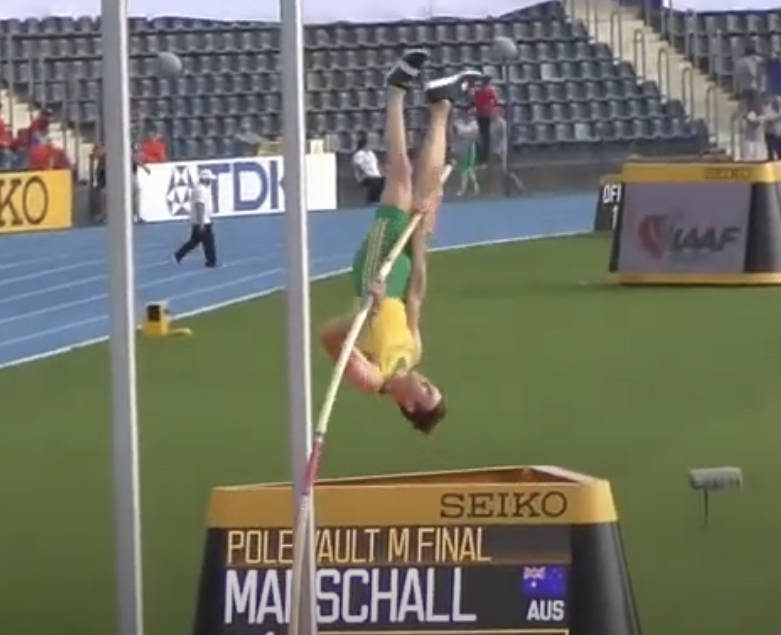The 1⁄2 drill is the first pole vaulting drills that we teach at RISE that is 100% an “off the ground” drill. The main point is to teach an athlete, through this drill, how to drop the head and shoulders simultaneously when having the top hand in the proper position at the time of the head and shoulder drop. This looks different for different developmental levels in pole vaulting.
Actually, over the years I put together a series of straight pole vaulting drills that were the prelude to the pole bending drills. This can be seen by the way all the straight pole drills are the same as the pole bending drills with the except of the pole bending because of a higher grips and a slightly farther approach run up.
Take a closer look at the 4 straight pole drills that we teach and you’ll see that the head and shoulder movement and hand placement is exactly the same as the pole bending drills. This is one reason it is difficult to master the bend pole series if a vaulter hasn’t mastered the straight pole series first.
I see vaulters in sessions do a couple straight pole drills and bent pole drills, and then just want to jump at a bungee. This is really not too much different that I did in the late 70s and early 80s. Just doing what I have to do so I can jump at a bar. It is scrimmaging 100%, and it will lead to injury, poor technical development and eventually frustration at the fact that they are not getting too much better. I didn’t know better. These kids know better because of their guidance at RISE, so there is no excuse not to do the pole vaulting drills.
Anytime I have a kid stay something about the idea that they are not getting better, I go over and point at the the chart on the wall that lists the pole vault drills. I then ask them how many of those drills they can do. Invariably, they can do only the beginning running plant drill and the beginning half drill. We have at RISE, all-state vaulters who can only do the beginning running plant drill and the beginning 1⁄2 drill!!! It’s too bad, because they could jump a lot higher if they learn the higher drill skill levels. We have to continue to encourage vaulters to up their skill and drill level. This is how they will achieve their dreams. Not by “scrimmaging” 100% of the time.
The best way to teach the beginner 1/2 pole vaulting drills is by increasing the approach distance and grip height of an On the Back straight pole drill. From an On the Back straight pole drill, I have a vaulter increase their grip by 2 fists and 1 left, so back from 3L to 4L. This usually still won’t bend the pole, but the increased speed from 3L to 4L usually can allow for a substantial increase in grip height, as long as it’s done slowly and safely. I do not emphasize that the pole should bend. I only say that eventually as the grip gets higher, the pole may start to bend a bit, and for them to not be alarmed. Some smaller and younger kids may eventually have to move their approach length back to 5L to get up enough speed to increase the grip. They are smaller and not as powerful, therefore they can’t generate as much horsepower as an older, larger, stronger vaulter. Everyone is different and adjustments have to be made to accommodate individuals based upon their unique characteristics.
How is a Beginner 1/2 Drill Characterized?
Remember this is an “off the ground” drill, so we are only coaching “off the ground” technique.
- Bottom is hand is lower than 9” above the forehead.
- Trail leg is bent considerably before the “L”
- The gap between the top hand and the like side knee cap is not closed.
- Low “J” position which results from only getting the feet to the top hand.
- Top hand (right hand for right handers) goes to left leg or hip.
- The angle between the top of the pit and the vaulter/pole is less than 45 degrees
- The vaulter is not lined up with the pole throughout the drill. Feet or bum hit pit first.
- The top hand is not on the midline of the body, between the legs/below the waistline upon the completion of the drill
- Vaulter lands in the pit too shallow (close to the box). All drills should land with their feet in the back 1⁄3 of the pit.
- The vaulter lands outside of 11 and 1 o’clock . Ideally the want to put their feet upon landing in the pit at 12 o’clock to the pit clock.
- The vaulter oftentimes lands with the feet or bum coming down to the pit before they can land flat on the back.
- Vaulters head stays up watching where they are going with is usually what causes a feet or bum first landing. It is important to release the head (not throw head) so that it is in a neutral position with the rest of the body in extension.
How is an Advanced 1/2 Drill Characterized?
Remember this is an “off the ground” drill, so we are only coaching “off the ground” technique.
- Bottom is hand is minimum 9” above the forehead.
- Trail leg is reasonably straight through the “J”.
- The gap is closed between the top hand and the like side knee cap in the “J”.
- Vaulter visually sees their top hand in the “J” before dropping the head and shoulders with the recoil of the pole. Timing the recoil of the pole up.
- Top hand (right hand for right handers) goes to right knee in the “J” and then between the legs when the head and shoulders drop (“J” to “I” transition).
- The angle between the top of the pit and the vaulter/pole is greater than 65 degrees.
- The vaulter is lined up with the pole throughout the drill.
- The top hand is on the midline of the body, between the legs/below the waistline upon the completion of the drill. Vaulter feet lands in back 1⁄3 of the pit between the 11 and 1 o’clock on the pit clock.
- Pole tip hops out of the box, over the collar and the vaulter times up the pole and stays alongside it on the completion of the drill.
- Vaulter lands back first.
In closing…
Things for coaches to consider when teaching the 1⁄2 drill:
- Some drills may require different pole length and weights. Rarely can all the RISE drills be executed well on the same size pole, gripping the same height.
- For a beginner, a more authentic way of learning the 1⁄2 drill is by increasing the approach length and grip height gradually. Moving from 3L on an “on the back” straight pole drill, to 4L or even 5L (in some instances), and bumping the grip a couple fists usually gets the ball rolling. Then gradually moving the step back to accommodate increases in grip until the pole starts bending, keeping in mind that we want the kids feet to be landing in the back 1⁄3 of the pit.
- It helps to have the vaulters who are learning the 1⁄2 drill to really focus on landing deep in the pit with their feet hitting between 11 and 1 o’clock on the pit clock.
- Encourage the RISERS to move beyond the Beginner 1⁄2 drill, and work on the skills involved with the Advanced 1⁄2 drill.
- The RISE 2112 encouragement pattern is usually every effective in rallying the kids and letting them know what they are doing well, and what they need to work on to reach their ultimate potential.
-CW

-CW


